
Rattlesnake Calathea
$28
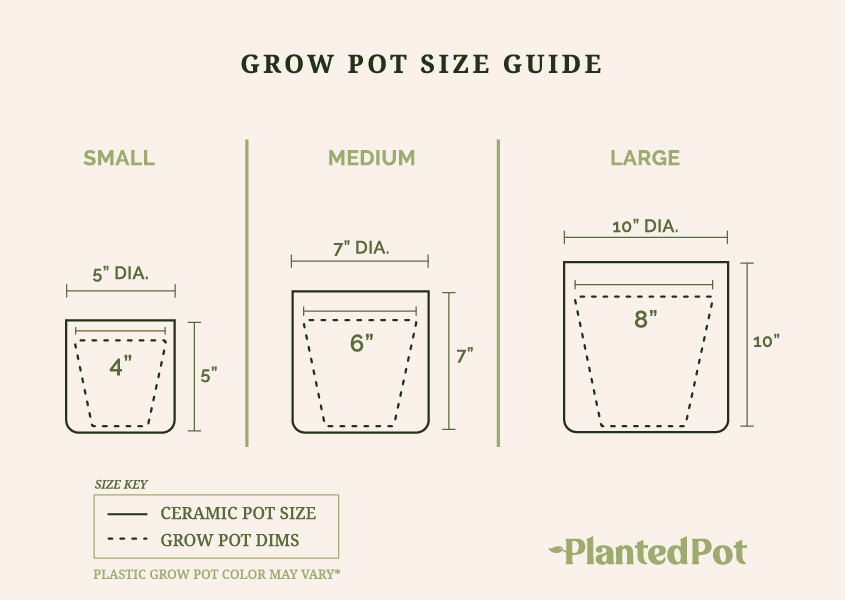 Plastic grow pots come in different colors, you may receive a black or rust colored pot.
Plastic grow pots come in different colors, you may receive a black or rust colored pot.
The Calathea Rattlesnake goes by many names for many reasons. Prominently connected to its reptile-like features, the Calathea Rattlesnake has bold waves of dark green that groove the tops of its leaves, which make its deep purple underside shine. Similarly, these plants rise and fall, day and night, according to their circadian rhythm. Hence, the Calathea Rattlesnake is known by many as the “prayer plant.” Regardless of their many names, these plants are very easy to take care of, requiring just a little light and gentle watering a few times a week. Unlike a rattlesnake, this plant is non-poisonous and safe if ingested by humans, dogs, or cats. Add a conversation piece to your living space with the Calathea Rattlesnake!
Medium to low indirect light, will scorch in direct sunlight.
Keep soil moist, not overstaurated. Light, frequent watering. Water more in May-August, less in winter months
65°- 85° F
Related Products
Rattlesnake Calathea
With its wavy leaves and dark green spots, the Rattlesnake Calathea is one of the most stunning houseplants you’ll ever come across. It’s a tropical plant that’s intricate in design but quite simple when it comes to plant care.
The Rattlesnake Calathea is a larger plant that has a few preferences to keep in mind, including bright, indirect light and a touch of humidity. Let’s take a closer look at how to take care of a Rattlesnake Calthea and find out what benefits you can get from this exotic plant.
What is a Rattlesnake Calathea?
Tall and vibrant, the Rattlesnake Calathea (aka the Rattlesnake Plant) is one of the most popular houseplants on the market. This Brazilian Rainforest native has large leaves that are wavy and full of beautiful shades of green. Darker green spots speckle the leaves, and the underside of each leaf is reddish-purple.
The Rattlesnake Plant is pretty easy to care for, making it great for beginners and seasoned plant owners alike. It can withstand some neglect, but if you want your plant to thrive, remember to keep close attention to it!
Plant Size
The Rattlesnake Calathea can reach an impressive 30 inches tall! This plant can be perfect for decorating your house, whether you place it in the corner of your room or as a centerpiece next to your TV.
Lighting
Place this plant in a sunny spot with bright, indirect light. This could be an indoor patio or a room with a lot of natural light. However, you should avoid putting this plant under direct sunlight, or it will lose the dark green spots on each leaf.
Temperature & Humidity
The Rattlesnake Plant is native to Brazil’s tropical rainforest atmosphere, which means that it needs a lot of warmth and moisture. However, it can adapt to most room temperatures!
Your house should never be below 60°Fahrenheit, or the leaves will droop and start to die. Try keeping your house between 65 – 75°F if you want this plant to thrive. Sudden temperature changes or the cold will cause the plant to get brown leaf tips and eventually die.
When it comes to humidity, try leaving a tray of wet rocks under the plant pot. The water will slowly evaporate and create a moist atmosphere around the plant. Many people also use humidifiers in the room where you keep your Rattlesnake Plant to boost the moisture content in the entire room.
Water
During the growing season in spring and summer, you should water your Rattlesnake Plant quite frequently. Throughout this period, the Rattlesnake Plant’s soil should be kept pretty moist. Remember that overwatering can cause root rot, which can severely damage the plant.
In the winter, only water this plant when the top of the soil is dry to the touch. Since plants are typically dormant during the colder seasons, you won’t need to water them as often.
Soil & Pot
While it’s important to not overwater your Rattlesnake Plant, it’s also just as important to have well-draining soil. The pot should be well-drained as well so that the water does not get trapped in the soil, causing root rot.
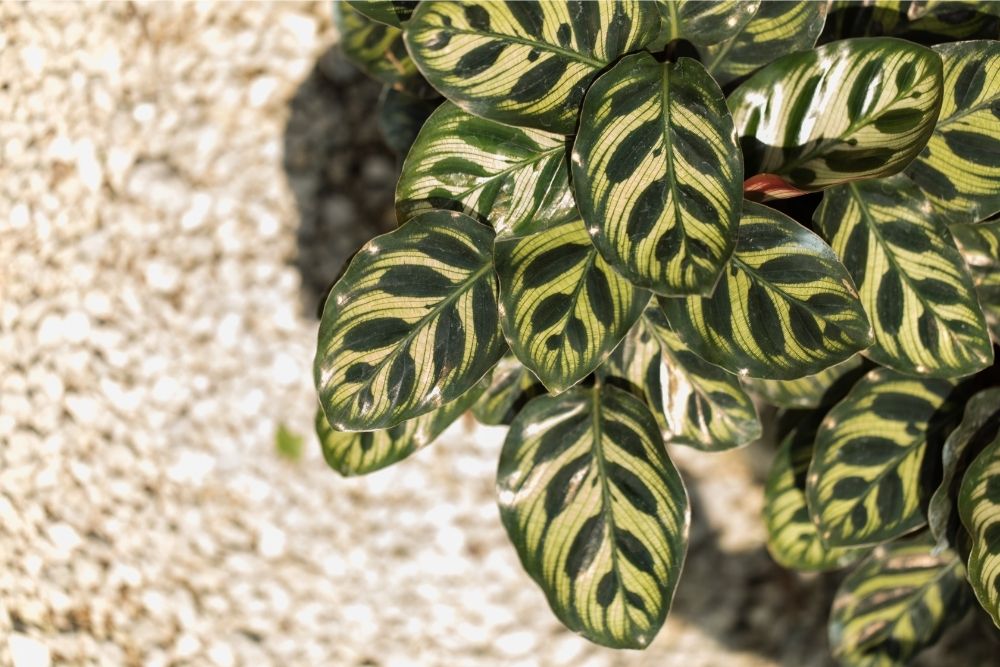
Why Choose a Rattlesnake Calathea Plant for Your Home?
The Rattlesnake Plant is known for its striking and one-of-a-kind beauty. Rattlesnake Plants are an amazing addition to most homes, whether you live in a city studio or a sprawling ranch in the countryside. With its unique and colorful appearance, this tropical plant looks stunning in almost every decor.
Purifies Air
Rattlesnake Calathea is more than just a stunning space filler. NASA recently performed a study on air purification power and found that most plants can free a home or office space of harmful contaminants in the atmosphere. You’ll probably need dozens of plants to do the job, so it most definitely doesn’t hurt to keep a few Rattlesnake Plants around to make you feel refreshed and healthy!
Plants can further improve air quality with photosynthesis, recycling carbon dioxide into oxygen. Plants with big leaves produce even more oxygen, meaning the Rattlesnake Plant’s large leaves are perfect for this! They can be great for your bedroom or office (wherever you spend most of your time).
The Rattlesnake Plant’s leaves have another added benefit. The leaves are known to trap dust! That means less dust on your room’s surfaces or in the air. Still, you’ll definitely want to wipe down your plant once in a while to keep it looking shiny and clean!
Increased Productivity
Studies have shown that having a touch of greenery in your home or office can improve your productivity as well. Keep your Rattlesnake Plant near your desk to feel clear-headed, creative, and inspired. Put one in your living room to help you stay alert while answering emails or cleaning. You’ll feel less stressed and more positive when you have this plant around!
Are Rattlesnake Calatheas Good Indoors & Outdoors?
Rattlesnake Calatheas are the perfect plants for any room, whether you choose to brighten up your bathroom or spruce up your study space. They’re easy to care for and provide a lot of benefits from beauty to wellness.
You can keep this plant outdoors as well, but the growing conditions may be harder to control, such as temperature, humidity, rain, etc.
Rattlesnake Plants are native to the tropical rainforest, so they can’t grow anywhere that gets cold. In addition, plant experts note that they can only grow in zones 10 and above, referring to the Plant Hardiness Zone Map.
Zone 10: This area includes southern California, southern Florida, and Hawaii. It’s not a large area of the United States. But these spots don’t fall below 30 degrees in the winter, which means you avoid freezing temperatures. This makes it the perfect zone for tropical plants.
Zone 11: This extremely warm zone includes Hawaii, the Florida Keys, and Puerto Rico for the most part. These locations have mellow winters (around 40 to 50 degrees) and zero days of frost. Tropical plants thrive in this zone thanks to long, hot summers and warm winters. But make sure plants are heat tolerant.
Zone 12 & 13: You won’t find these zones in the continental United States. They’re only in Hawaii and Puerto Rico. These zones are extremely warm and tropical, meaning plants must be suited for intense heat. It’s the warmest of all USDA hardiness zones, and you’ll also find exotic fruits.
Because most of the United States isn’t within one of these four zones, it’s not recommended to grow the Rattlesnake Calathea outside. It will most likely get too cold for the plant to survive. Luckily they can thrive indoors if you keep your home at a certain temperature, making them easy to care for and fun to have around.
Are Rattlesnake Calathea Plants Pet and Children Friendly?
Despite its sinister-sounding name, the Rattlesnake Plant is pet and child-friendly. It’s not a poisonous plant. That means curious kitties are free to nibble on the enchanting leaves and dig in their moist soil. Kids can also admire this glorious plant without you having to worry about their safety.
The American Society for the Prevention of Cruelty to Animal (ASPCA) also notes that Rattlesnake Plants are safe for horses!
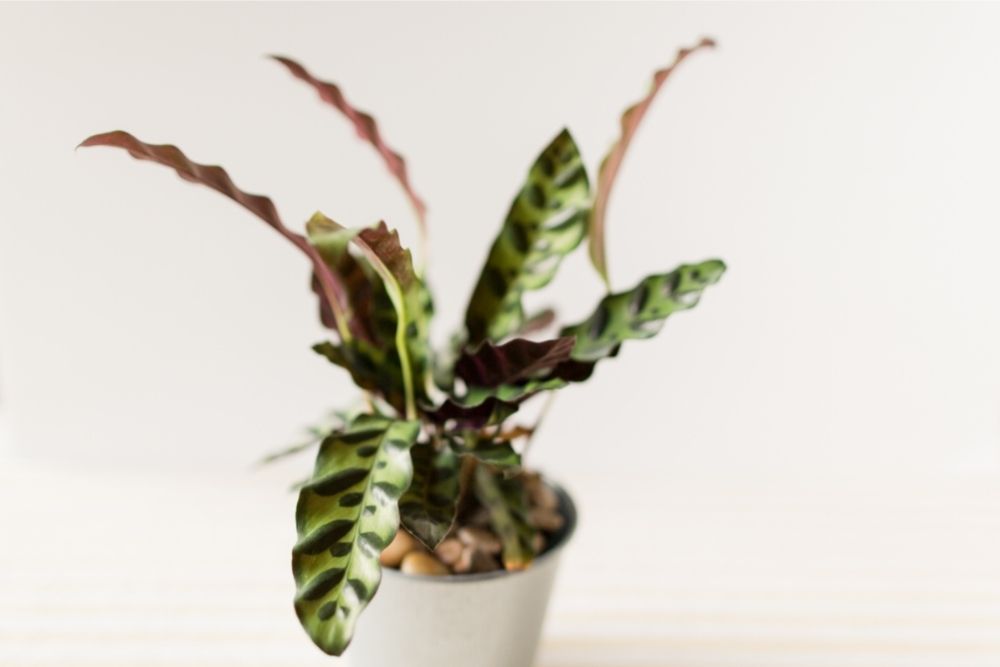
Rattlesnake Calathea Plant Family Relatives
The Rattlesnake Plant is part of the Arrowroot family of plants, also known as the Marantaceae. These flowering plants are found in lowland tropical forests throughout Africa, Asia, and the Americas. Almost 80% of Rattlesnake Plants are found in the American tropics.
There are 31 genera and around 530 species of plants in the Arrowroot family. Here are some of the most common ones:
- Water Canna: Native to South America, this has blue-green foliage and grows about four to six feet tall. Its leaves get to be around 18 inches long. Their flowers are a pale yellow. This plant is known to grow well in shallow water.
- Triostar Stromanthe: Also known as the Tricolor Stromanthe, this is a colorful plant with an eye-catching tropical appeal. This plant will grow 2-3 feet tall and about 1-2 feet across. It’s native to the jungles of Brazil, sporting elegant green leaves with touches of pale colors like cream and pink. It features deep pink or maroon underneath. You’ll see the underside when it folds up its leaves at night.
Plants That Are Similar to the Rattlesnake Calathea
While the Rattlesnake Plant is quite unique in its appearance, there are surprisingly some other plants that have a similar look if you want some plants to match!
- Prayer Plant: The Prayer Plant is a tropical plant with beautiful, decorative leaves and is also native to Brazil. It features a tricolor appearance with deep green, yellow splotches, and red veins. This plant will reach up to a foot tall inside but will grow quite slowly. At night, the Prayer Plant’s leaves will move to point upward. They can be a little picky, but for many people, the extra care is worth it.
- Calathea Orbifolia: With large, round leaves and a metallic-like pattern, the Calathea Orbifolia is a striking houseplant that will catch the eyes of any guest. The leaves can grow 12 inches wide, and the plant can become 2.5 feet tall and wide, making them a pretty thick plant.
- Peacock Plant: Also known as Cathedral Windows, this is one of the most beautiful plants you’ll ever see, thanks to its oval leaves and colorful markings. The thin leaves have purple underneath and light green on top, with dark green peacock-like markings (hence the name). The leaves can grow up to 12 inches long. The stems are dark pink, giving it even more color. Keep their soil moist and keep your house hot (between 60-75°F).
- Pinstripe Plant: This popular houseplant comes from Columbia and Ecuador. It features dark green leaves with purple underneath as well as long, green stems. The plant gets its name from the pink pin-stripes on each leaf (which can grow over a foot long). The plant itself can get around 2 feet tall and 2 feet wide. The Pinstripe Plant prefers humidity, so consider a pebble tray underneath the pot or a humidifier.
- Zebra Plant: This tropical perennial is often found in Brazil. It has attractive, light green leaves with a velvet texture and a purple underside. Each leaf has dark green stripes, hence the name! The Zebra Plant’s leaves can grow 12 inches tall and fold at night. This plant requires moist, fertile soil with good drainage as well as warm temperatures between 54-80°F.
Final Thoughts – Rattlesnake Calathea
If you’re looking for a colorful and interesting plant that’s easy to take care of, the Rattlesnake Plant is for you. It’s a bright, tropical plant that thrives in warm weather with a touch of humidity. In return, you will get spotted leaves with a striking, wavy texture. The leaves are also great dust collectors and will provide you with cleaner air.
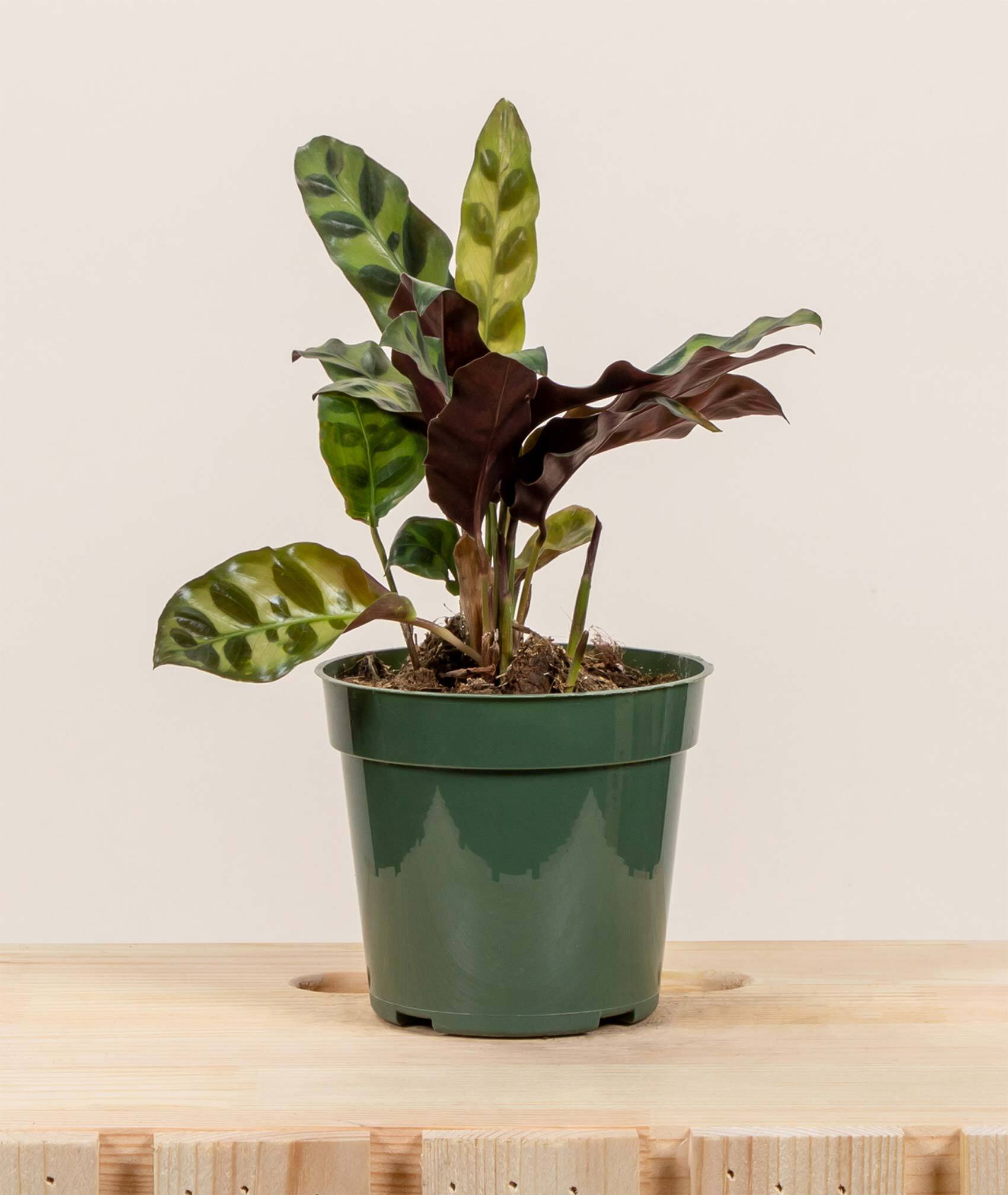
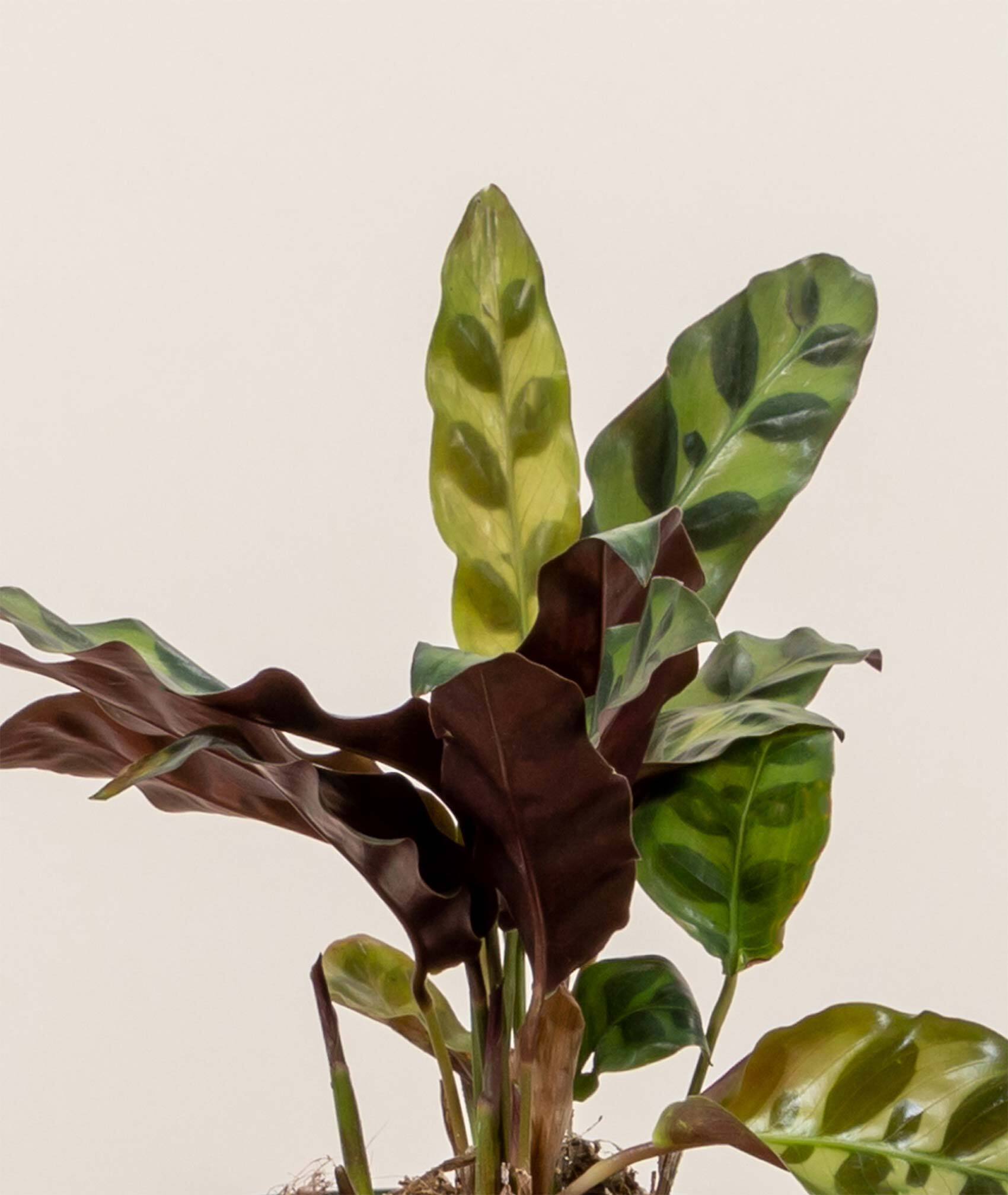



Reviews
There are no reviews yet.